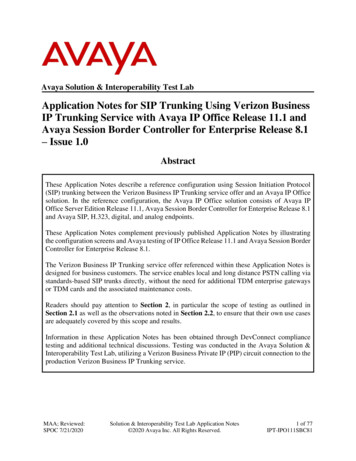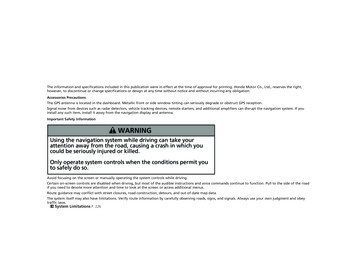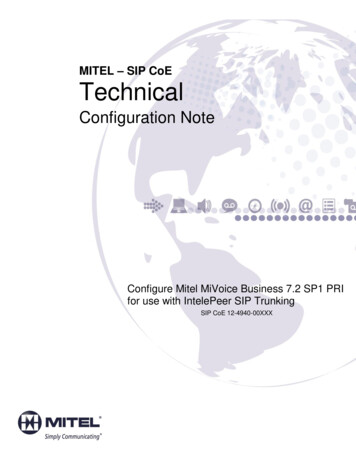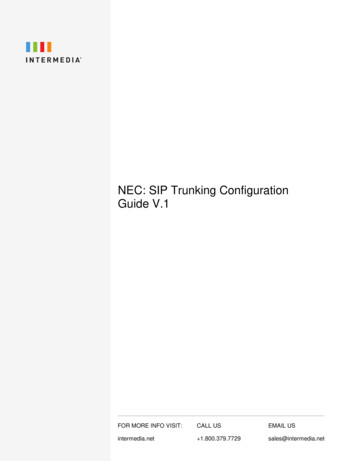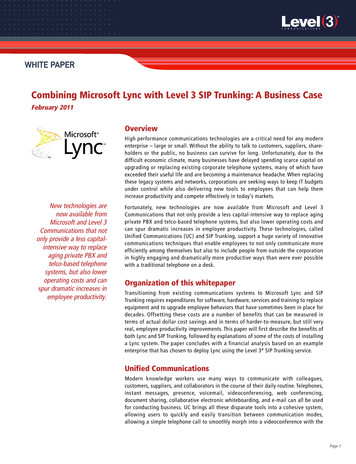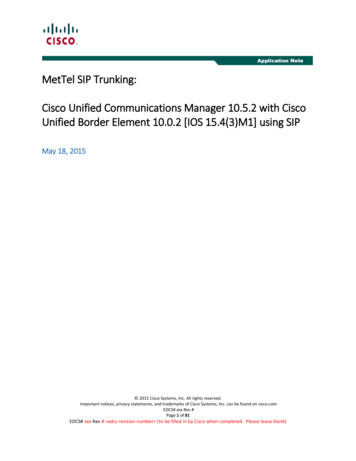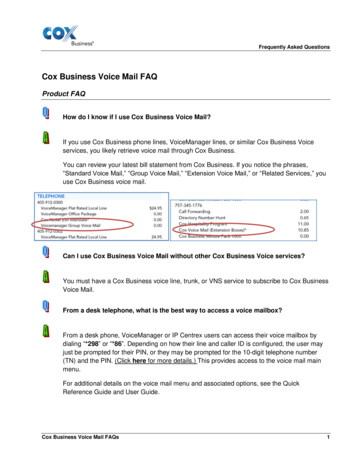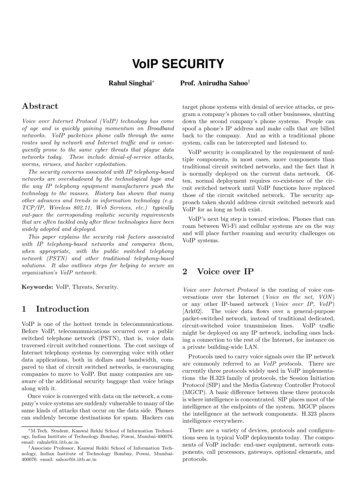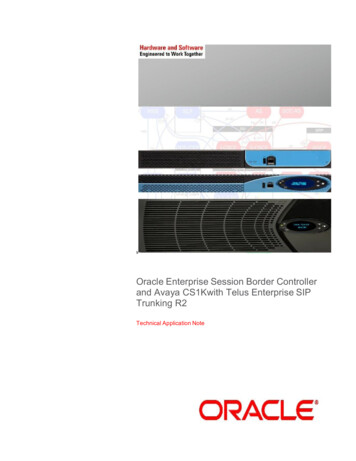
Transcription
Voice Trunking in an IP World:Charting a Practical Path for PRI and SIPMichael HarrisKinetic Strategies
01Time Warner Cable Business ClassWhite Paper: Voice Trunking in an IP World: Charting a Practical Path for PRI and SIPVoice Trunking in an IP World:Charting a Practical Path for PRIand SIPInformation technology (IT) leaders understand that a converged InternetProtocol (IP) network is the endgame for innovative organizations. However,the real-world road to All-IP means leveraging existing technologyinvestments as well as intelligently integrating leading-edge IP capabilities.Utilizing Session Initiation Protocol (SIP) trunking for IP PBX telephonesystems is a practical step in the evolution of business networks that currentlyrely on Primary Rate Interface (PRI) connections.The IP PBX EdgeThree out of four U.S. companies have adopted IP PBX solutions to reducetelephone system operating costs and complexity while enabling features thatdrive productivity¹. IP PBXs use SIP—a signaling communications protocolfor IP networks—to route voice, video and messaging traffic through anorganization’s data network. With feature-rich SIP enabled IP phones thatconnect to the company LAN via Ethernet or Wi-Fi, office telephoneextensions become virtual rather than physical. SIP phones are also offeredas software clients for computers, laptops, smartphones and tablets, allowingworkers to receive calls and messages anytime, anywhere across a range ofwireline and wireless services.“More than 80 percent ofcompanies with more than 100employees say SIP is veryimportant to their business.”According to a recent survey, 40 percent of companies are leveraging SIP tosupport unified messaging, presence management or softphone clients onPCs or mobile devices². Rather than guessing whether a colleague is readyto communicate, presence offers real-time information about individualavailability and how best to reach that person—via office phone, mobilephone, instant messaging, videoconference or other means. With SIP, voicecalls and messaging can also be linked with customer relationshipmanagement (CRM) applications. For example, as incoming call numbers arerecognized, the customer service associate sees a pop-up window withinformation about the caller. Likewise, click-to-call features within CRMapplications speed outbound dialing. Not surprisingly, more than 80 percent ofcompanies with more than 100 employees report that SIP is very important totheir business3.Figure 1Top Factors for Deploying IP VoiceCost savingsFoundation for UCFeature functionalityCustomer service/support integrationCollaboration application integrationImprove productivityEase of managementSource: IDC10% 20% 30% 40% 50%In a recent survey by IDC, businesses reported the following top factors fordeploying IP voice: cost savings, building a foundation for unifiedcommunications (UC), adding feature functionality, integrating with customerservice and collaboration applications, improving productivity and ease ofmanagement for IT staff4. (See Figure 1.)
Time Warner Cable Business ClassWhite Paper: Voice Trunking in an IP World: Charting a Practical Path for PRI and SIP02Debunking TrunkingBy using TDM-IP voice gateways that link their IP PBX to the Public SwitchedTelephone Network (PSTN), businesses have been able to realize many of thebenefits of SIP without having to replace existing connections with telecomcarriers. These carrier connections, called trunks in telecom speak, aretraditionally offered as PRI services. PRI trunks deliver voice traffic as part ofIntegrated Services for Digital Network (ISDN) specifications that interfacewith the PSTN.PRI trunks are usually offered in blocks of 24 channels (23 for voice and 1 forsignaling) through T1 or DS3 circuits. This fixed-channel allocation has longbeen a source of frustration for IT managers. When it needs extra callcapacity, a growing organization is often forced to buy a block of 24 channels,even when far fewer are actually required. Fortunately, some innovativecarriers now offer fractional PRI services, enabling organizations to purchasedigital voice channels in smaller increments, such as 8, 12 or 16.SIP trunking offers even more flexibility and granularity, enabling organizationsto purchase the exact number of call paths needed. Better yet, there is noneed for TDM-IP gateways that support the conversion of IP packets to PSTNtraffic over an ISDN PRI circuit. With SIP trunking, organizations cansupplement or bypass PRI infrastructure, extending the benefits of IP and SIPbeyond the internal IP PBX edge.Five Key Benefits of SIP TrunkingAs well as a future-proof network evolution path, SIP trunking offerscost-savings on telephone service charges and legacy equipment upgrades,flexibility in scaling call capacity, enhanced business continuity capabilities,unified communications and efficiencies through All-IP convergednetworking. Let’s look at the five key advantages of SIP trunking in more detail.1. Cost Savings: SIP trunking helps organizations reduce costs by supportingthe convergence of separate voice and data networks, consolidatingoperational support staff, reducing equipment needs and enabling thepurchasing of only the required calling capacity.Ovum, a leading telecomresearch firm, finds that businesses normally realize network and usage costsavings within the first few months of transitioning to SIP trunking, and mostorganizations achieve “more than 60 percent cost savings over existinginfrastructures and trunking services.”5“SIP trunking can generally resultin more than 60% cost savingsover existing infrastructures andtrunking services.”2. Scalability: Rather than buying PRI trunks in fixed blocks of 24 channels, SIPtrunking capacity can be scaled more flexibly. As it adds PRI channel blocks,the organization may also need to add capacity to the legacy voice-gatewayhardware interconnecting its IP PBX with PRI circuits—an approach that canbe more costly and cumbersome. SIP trunking provides a native SIP interfacebetween the customer IP PBX and the service provider IP network and allowsgranular scaling of call capacity over IP data connections. Additonally, SIPtrunking eliminates the need for on-site installation and offers rapid softwarebased provisioning of additional capacity in as little as one call path at a time.As a result, your organization will be more nimble and able to respond quicklyto system and application growth needs.3. Alternate Routing and Business Continuity: The enhanced failovercapabilities of SIP trunking benefits business continuity and disaster recoverystrategies.
Time Warner Cable Business Class“SIP trunking is more flexible andefficient, and thus can provide partof the hard savings needed tosupport a UC business case.”03White Paper: Voice Trunking in an IP World: Charting a Practical Path for PRI and SIPFigure 2SIP Trunking Alternate Routing & Business TN2:45 O8PQRSHOLDDEFJKLSEND2:45 UTEMSG2ABC5JKL8TUV0OPERSPEAKERSERVICE PROVIDERLINE4Customer PortalCLEAR3DEF6MNO9WXYZAlternate Routing Table#SENDFailover SiteSIP TrunkLAN SwitchIP PBXEquipment failure214-555-00002:45 quartersSIP trunks can be programmed to support automatically triggered alternate routes by phone numberparameters in the event of a system, PBX or network failure. Many providers offer customer administrationportals for ease of setup and management.For example, SIP trunking can be configured to automatically route calls toanother telephone number or trunk group during a connection failure and,following restoration, return call traffic to the primary destination. (SeeFigure 2.)“North American businesses areusing a combination of services;there isn’t going to be a 100%cutover [from PRI] to SIP.”4. Unified Communications: Businesses are embracing UC to enhancecollaboration and responsiveness. SIP is an essential element in many UCapplications, such as instant messaging and presence, unified messagingand audio/video/web conferencing, as well as mobile softphone apps. SIPtrunking helps keep UC applications on the IP network, avoiding chargesassociated with PSTN termination and interconnection. As StrategicNetworks Group explains, “SIP trunk services act as the glue to supportmulti-location VOIP, IM, web or IP videoconferencing applications. Comparedto many legacy carrier access lines and trunks, SIP trunks are more flexibleand efficient, and thus can provide part of the hard savings needed tosupport a UC business case.”65. All-IP Networking: SIP trunking may serve as an essential building block formigrating to a flexible All-IP network that delivers voice, data and videotraffic. By handling SIP voice calls as IP data, SIP trunking provides anext-generation solution for supporting your network evolution needs.The Hybrid PathAll-IP network idealists can learn lessons from the energy-efficient vehiclemarket. While all-electric vehicles are the ultimate approach, they accountfor less than 15 percent of electric-capable vehicle sales. Hybrids dominatethe industry.Likewise, while 75 percent of U.S. companies have adopted IP PBXs, only 13percent of organizations exclusively employ SIP trunking to link their IP PBXwith telecom service providers7.
Time Warner Cable Business ClassWhite Paper: Voice Trunking in an IP World: Charting a Practical Path for PRI and SIP04Figure 3Business Use of SIP and PRI Trunks 2013-201580%60%SIP TrunksPRI Trunks40%20%Source: Infonetics Research20132015To leverage their legacy voice investments, organizations often pursue ahybrid path that includes both PRI and SIP trunking solutions as part of aphased migration of their network to IP services. That said, SIP trunks arepoised to overtake PRI services as organizations steadily evolve towardconverged IP networks. Currently, 38 percent of businesses use SIP trunks.That total is expected to reach 58 percent in 2015. Over the same period theuse of PRI trunks is forecast to decline from 71 percent to 55 percent ofbusinesses. (See Figure 3.)“The WAN configuration decisionwill depend on the number of officelocations, as well as the mix ofusers, devices and applications ateach location.”According to Infonetics Research, “North American businesses are using acombination of services; there isn’t going to be a 100% cutover [from PRI] toSIP.” Therefore, service providers that can aid in this evolution by offeringboth PRI and SIP trunking solutions may prove to be preferred partners.Loading SIP TrunksSome carriers bundle bandwidth and quality of service (QoS) with SIP trunkingto simplify network cost and capacity planning. Other service providersrequire the customer to handle SIP trunking traffic engineering and QoSconsiderations. For those organizations that must do their own trafficengineering for SIP trunking, the required bandwidth is calculated based onthe projected number of concurrent voice calls. One simple formula for thiscalculation can be expressed as:SIP Trunk Peak Bandwidth Maximum Simultaneous Calls 100 kbps9With this formula SIP trunk capacity for 10 concurrent calls equates to1 Mbps of bandwidth.Trunks and BranchesA key decision for organizations with multiple operating locations is whetherto centralize or distribute SIP trunking. This choice is driven by several factors,including the current and planned PBX architecture, the use of unifiedcommunications, the geographic distribution of branch office locations,branch office bandwidth utilization and redundancy needs.
Time Warner Cable Business Class05White Paper: Voice Trunking in an IP World: Charting a Practical Path for PRI and SIPFigure 4SIP Trunks Enable IP PBX Extensions for On-net calling and Support forSIP/VoIP PhonesPSTN“Select a provider that owns itslast-mile network and can offerfuture-proof fiber and Ethernetsolutions.”InternetLAN Switch2:45 UTEMSG2ABCDEF69#JKLTUVOPERSPEAKERMNOWXYZ2:45 3580MNOSERVICE PROVIDEREthernetIP PBX2:45 #clearenterSIP trunkCampus & other locationsHeadquartersSIP trunks support “on-net” call traffic delivered as IP data over the company network to other locations.An array of SIP enabled IP phone types that connect to the company LAN are supported along with IP PBXbased 4 digit dial plans that increase efficiency and reduce costs.Most organizations are incented to centralize their IP PBX solution rather thandistribute the functionality at branch offices.With a centralized IP PBX, SIP call traffic can be transported over theorganization’s local and wide area networks. Internal “on-net” call traffic isdelivered as IP data within the company—minimizing carrier trunk and tollcharges—and external “off-net” traffic destined for the PSTN is terminatedwith centralized SIP or PRI trunks. (See Figure 4.)Organizations may consider a distributed approach when geographic distanceadds network delay undermining call quality or when bandwidth usage strainslinks between remote sites. A common design guideline is to centralize SIPtrunks if branches consume less than 20 percent of wide area network (WAN)bandwidth.When branch-location WAN-bandwidth utilization approaches or tops 50percent, a distributed SIP trunking approach may be preferred10. DistributedSIP trunking may also be selected as a way to add redundancy by avoiding asingle point of failure for PSTN interconnection.Choosing a ProviderSIP trunking can deliver reliability and security comparable to PRI trunks whileoffering cost savings and innovative features. Whether the potential of SIPtrunking is fulfilled depends on the service provider partner selected.Organizations should consider the following six factors in the decision-makingprocess.1. Facilities-Based Foundation: When evaluating SIP trunking services, selecta provider that owns its last-mile network and can offer future-proof fiber andEthernet solutions. Facilities-based providers with broad network reach arebetter able to guarantee service quality. Using a variety of accesstechnologies, they may also be able to serve a wide range of businesslocations, from office parks and business centers to small office, branchoffice, retail, medical and municipal buildings.2. Service Level Agreements: Because voice reliability is so critical tobusiness productivity, be sure to select a SIP trunking provider that offersservice level agreements (SLAs). Such agreements set performance
Time Warner Cable Business ClassWhite Paper: Voice Trunking in an IP World: Charting a Practical Path for PRI and SIP06benchmarks for service reliability and, should an unplanned outage occur,responsiveness for repair and restoration as well as compensation.3. Circuit and Packet Support: Because most organizations employing SIPtrunking still use PRI services to connect to the PSTN, partnering with aprovider that offers both solutions may simplify service management and yieldcost savings.4. Call Path Bandwidth: While it may be beneficial for some organizations toconverge SIP trunking into their carrier data connections, others find doing somay create bandwidth contention and traffic management challenges. Avoidthis problem with voice-only SIP trunks that provide dedicated and scalablecall paths, simplifying network cost and capacity planning while ensuringvoice application performance.5. Alternate Routing and Trunk Overflow: Alternate routing automaticallyswitches incoming calls to another telephone number in the event of a serviceoutage, even when due to a PBX failure.Similarly, SIP trunking overflow solutions automatically reroute inbound callsto a designated phone number when all provisioned call paths are in use.Some service providers offer similar features for PRI as well. Because thesecall failover capabilities impact network uptime, be sure a prospective serviceprovider supports them for both PRI and SIP.6. Equipment and Interoperability: To simplify installation and integration, someproviders include customer-premises equipment (CPE) for SIP trunkingconnectivity and pre-test IP PBX system compatibility. With this “plug-andplay” deployment option, organizations need not navigate the SIP trunkingterrain alone.Flexible and Future-ProofSIP trunking extends the benefits of IP communications beyond the companyLAN and WAN into carrier networks. Organizations may choose to deploy SIPtrunking to supplement or bypass PRI infrastructure, offering a flexible andfuture-proof approach to IP network evolution. Selecting the right serviceprovider is an essential ingredient in the success of any SIP trunkingdeployment.
Time Warner Cable Business ClassWhite Paper: Voice Trunking in an IP World: Charting a Practical Path for PRI and SIP07About the AuthorMichael Harris is principal consultant at Phoenix, Arizona-based KineticStrategies, Inc. Applying more than 15 years of experience as a strategist,research analyst and journalist, Michael consults with select clients in thenetworking, Internet and telecommunications industries.About Time Warner Cable Business ServicesTime Warner Cable Business Services, a division of Time Warner Cable, offersa full complement of business communications tools to small, medium andenterprise-sized companies under its Time Warner Cable Business Classbrand. Its Internet, voice, television, network and cloud services are enhancedby award-winning customer service and local support teams. Through itsNaviSite subsidiary, Time Warner Cable Business Services, also offersscalable managed services, including application services, enterprise hosting,and managed cloud services primarily in the U.S. and U.K. Time Warner CableBusiness Services, founded in 1998, serves approximately 625,000 businesscustomers throughout Time Warner Cable's service areas. For moreinformation, visit http://business.twc.com. 2014 Time Warner Cable. All Rights Reserved.1“Strategic, User-Driven, and Managed: the Future of Unified Communications and Collaboration. Key findings from a major global Dimension Data and Ovumstudy,” Dimension Data (March 2013).2“Strategic, User-Driven, and Managed: the Future of Unified Communications and Collaboration. Key findings from a major global Dimension Data and Ovumstudy,” Dimension Data (March 2013).3“SIP Market Size Analysis and Forecast 2013–2018,” The Eastern Management Group (September 2013).4“2012 US WAN Manager Survey,” IDC (May 2013), survey of businesses deploying SIP trunks5“SIP Trunking: Second-Wave Benefits,“ Ovum (January 2011).6“SIP Trunk Services: The Foundation of Unified Communications,” by Lisa Pierce, Strategic Networks Group, http://www.nojitter.com/post/222600820.7“SIP Market Size Analysis and Forecast 2013–2018,” The Eastern Management Group (September 2013).8“SIP Trunking and SBC Strategies: North American Enterprise Survey,” Infonetics Research (March 2013).9Time Warner Cable Business Class engineering estimate.10“SIP Trunking Deployment Models: Choose the One That Is Right for Your Company,” Cisco Systems (2012).
Utilizing Session Initiation Protocol (SIP) trunking for IP PBX telephone . systems is a practical step in the evolution of business networks that currently rely on Primary Rate Interface (PRI) connections. . need for TDM-IP gateways that support the conversion of IP packets to PSTN traffic over an ISDN PRI circuit. With SIP trunking .
